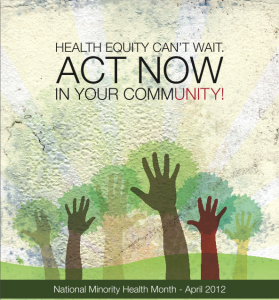LatinaLista — For over 20 years, there has been an Office of Minority Health (OMH) at the federal level. It was created because it became evident that black, Latino and other patients of color were not enjoying the same positive outcomes for their medical conditions as white patients.

Poor health outcomes for African Americans, Hispanic Americans, American Indians and Alaska Natives, Asian Americans, Native Hawaiians, and Pacific Islanders are apparent when comparing their health indicators against those of the rest of the U.S. population. These populations experience higher rates of illness and death from health conditions such as heart disease, stroke, specific cancers, diabetes, HIV/AIDS, asthma, hepatitis B, and overweight and obesity.
The OMH has striven to educate and heighten awareness among communities of color about what to do to lead healthier lives. One way to heighten that awareness has been to designate April as National Minority Health Month. Another way to address these disparities in health outcomes was implemented in 2010 when the Affordable Care Act was passed.
The Act called for the establishment of OMH offices within six agencies of Health and Human Services: the Agency for Healthcare Research and Quality (AHRQ); the Centers for Disease Control and Prevention (CDC); the Centers for Medicare & Medicaid Services (CMS); the Food and Drug Administration (FDA); the Health Resources and Services Administration (HRSA); and the Substance Abuse and Mental Health Services Administration (SAMHSA).
If the Affordable Care Act, sarcastically referred to as Obamacare, is stricken down by the Supreme Court, who is currently reviewing it, the future of improving the odds for the health outcomes of people of color could be diminished.
However, in Texas, one state legislator made sure that blacks and Latinos would not suffer from lack of information or education when it comes to one particular disease — cancer.
Texas Rep. Ruth Jones McClendon of San Antonio passed HB 114 in 2011 designating April as Texas Minority Cancer Awareness Month. Rep. McClendon is a cancer survivor.
This year marks the first-ever observance of a disease that is as color blind as it is deadly. Yet, records show that cancer is far deadlier for people of color.
African Americans with cancer have the highest death rate and shortest survival of any other race or ethnicity. In fact, when compared to white men and women, the death rate is an astounding 32% higher for African American men and 16% higher for African American women.
Hispanics are less likely to see a doctor and more likely to have cancer detected at a later stage when it is more difficult to treat. Hispanics have higher rates of less common cancers like stomach, cervix, and liver.
Most diseases don’t have to lead to inevitable death if a few healthy practices are followed in life:
1. Don’t smoke.
2. Eat more fruits and vegetables.
3. Exercise more.
4. Get cancer screenings — pap, colon, breast.
5. Go to the doctor.
Yet the most important information for those who don’t have health insurance is to find out where are the free clinics in the community. For help, people can call the American Cancer Society at 1-800-227-2345.
With or without the Affordable Care Act or National Minority Health Month, keeping healthy is a life-long responsibility that everyone owes to themselves. The benefits of watching out for our health are lives with less pain and family members not having to shed tears for a death that didn’t have to happen.




